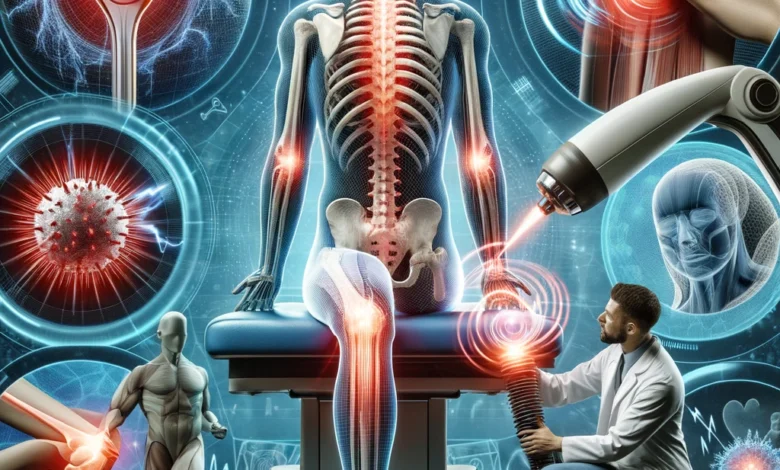Innovative Approaches in Pain Management: The Role of Shock Wave Therapy

Introduction
Pain management has always been a crucial aspect of medical science, as millions of people around the world suffer from chronic pain conditions that significantly impact their quality of life. Traditionally, pain management has relied heavily on medications, physical therapy, and surgical interventions. However, these methods often come with side effects, risks, and varying degrees of effectiveness. In recent years, innovative approaches in pain management have gained traction, with shock wave therapy (SWT) emerging as a promising treatment option. This blog will explore the role of shock wave therapy in pain management, its mechanisms, applications, benefits, and potential limitations.
Understanding Shock Wave Therapy
Shock wave therapy is a non-invasive treatment method that utilizes acoustic waves to treat various musculoskeletal conditions. Originally developed to disintegrate kidney stones, SWT has evolved to address a wide range of medical conditions, including chronic pain. The therapy involves the application of high-energy sound waves to the affected area, which promotes healing and pain relief through several physiological mechanisms.
Mechanisms of Action
- Cellular Response: Shock waves stimulate cellular activity, leading to the release of growth factors and cytokines that promote tissue regeneration and repair. This enhances the body’s natural healing processes.
- Increased Blood Flow: The acoustic waves improve blood circulation in the targeted area, ensuring better oxygen and nutrient delivery to the tissues. This can accelerate the healing of damaged tissues and reduce inflammation.
- Pain Modulation: Shock waves can desensitize nerve endings and interrupt pain signal transmission, providing immediate pain relief. This is achieved through the modulation of nociceptor activity.
- Mechanical Effects: The mechanical force of shock waves can break down calcifications and adhesions in soft tissues, improving mobility and reducing pain caused by these structural abnormalities.
Applications of Shock Wave Therapy in Pain Management
Shock wave therapy has found applications in various medical fields due to its effectiveness in managing pain and promoting tissue healing. Some of the common conditions treated with SWT include:
Musculoskeletal Pain
- Plantar Fasciitis: SWT is highly effective in treating plantar fasciitis, a common cause of heel pain. The therapy reduces inflammation and promotes healing of the plantar fascia.
- Tendinopathies: Conditions like Achilles tendinopathy, patellar tendinopathy, and lateral epicondylitis (tennis elbow) can benefit from shock wave therapy. The treatment promotes collagen synthesis and tendon repair.
- Myofascial Pain Syndrome: SWT can alleviate myofascial pain by breaking down trigger points and improving blood flow to the affected muscles.
- Osteoarthritis: Shock wave therapy has shown promise in managing pain and improving joint function in patients with osteoarthritis by stimulating cartilage repair and reducing inflammation.
Sports Injuries
Athletes frequently experience acute and chronic injuries that can benefit from shock wave therapy. Conditions such as stress fractures, shin splints, and muscle strains can be effectively managed with SWT, leading to faster recovery and return to sports activities. To shock wave therapy get visit here : https://www.ultimatemedgroup.com/prolotherapy
Chronic Pain Conditions
- Lower Back Pain: Chronic lower back pain, often caused by conditions like herniated discs or facet joint arthritis, can be managed with SWT. The therapy helps reduce pain and improve mobility.
- Shoulder Pain: Conditions like rotator cuff tendinopathy and calcific tendinitis can be treated with shock wave therapy, providing pain relief and enhancing shoulder function.
- Neuropathic Pain: Emerging research suggests that SWT may have a role in managing neuropathic pain conditions by modulating nerve activity and promoting nerve regeneration.
Benefits of Shock Wave Therapy
Shock wave therapy offers several advantages over traditional pain management methods, making it an attractive option for both patients and healthcare providers.
Non-Invasive and Low Risk
One of the most significant benefits of SWT is its non-invasive nature. Unlike surgical interventions, shock wave therapy does not require incisions or anesthesia, reducing the risk of complications and recovery time. The procedure is generally well-tolerated, with minimal side effects.
Effective Pain Relief
Numerous studies have demonstrated the efficacy of shock wave therapy in providing pain relief for various conditions. Patients often experience significant improvements in pain levels and functional outcomes after a few treatment sessions.
Quick Recovery
Since SWT is a non-invasive procedure, patients can return to their daily activities shortly after treatment. This is particularly beneficial for athletes and individuals with busy lifestyles who cannot afford extended downtime.
Long-Lasting Effects
Shock wave therapy not only provides immediate pain relief but also promotes long-term healing. The regenerative effects of the therapy can lead to sustained improvements in pain and function, reducing the need for ongoing treatments.
Limitations and Considerations
While shock wave therapy has shown great promise, it is important to consider its limitations and potential challenges.
Variable Efficacy
The effectiveness of shock wave therapy can vary depending on the condition being treated, the severity of the condition, and individual patient factors. Some patients may not respond as well to the therapy, requiring alternative treatment approaches.
Treatment Protocols
Optimal treatment protocols for shock wave therapy, including the number of sessions, energy levels, and treatment intervals, are still being refined. Personalized treatment plans are essential to achieve the best outcomes for each patient.
Cost and Accessibility
Shock wave therapy can be expensive, and not all healthcare providers have access to the necessary equipment. This can limit the availability of the treatment for some patients, particularly in underserved areas.
Emerging Research and Future Directions
The field of shock wave therapy is continually evolving, with ongoing research exploring new applications and refining existing protocols. Some of the exciting developments in SWT include:
Enhanced Technology
Advancements in shock wave therapy technology are improving the precision and efficacy of treatments. Newer devices offer better control over energy levels and treatment parameters, leading to more effective and targeted therapies.
Combination Therapies
Researchers are investigating the synergistic effects of combining shock wave therapy with other treatments, such as platelet-rich plasma (PRP) injections, physical therapy, and pharmacological interventions. These combination therapies may enhance the overall effectiveness of pain management strategies.
Expanded Applications
Emerging evidence suggests that shock wave therapy may have applications beyond musculoskeletal conditions. Researchers are exploring its potential in treating conditions like chronic wounds, erectile dysfunction, and even certain neurological disorders.
Mechanistic Insights
Ongoing studies aim to deepen our understanding of the underlying mechanisms of shock wave therapy. By elucidating the cellular and molecular pathways involved, researchers can optimize treatment protocols and develop new therapeutic targets.
Patient Perspectives and Testimonials
Patient experiences and testimonials provide valuable insights into the real-world impact of shock wave therapy. Many patients report significant pain relief and improved quality of life after undergoing SWT. These testimonials highlight the importance of personalized treatment plans and the potential for SWT to transform pain management.
Case Study: Sarah’s Journey with Plantar Fasciitis
Sarah, a 45-year-old avid runner, had been struggling with chronic heel pain due to plantar fasciitis for over a year. Traditional treatments, including physical therapy and corticosteroid injections, provided only temporary relief. Frustrated and unable to continue her running routine, Sarah decided to try shock wave therapy.
After just three sessions of SWT, Sarah experienced a significant reduction in pain. She was able to gradually resume her running activities and eventually returned to her regular training regimen. Sarah’s story exemplifies the potential of shock wave therapy to provide long-lasting relief for chronic pain conditions.
Conclusion
Shock wave therapy represents a significant advancement in pain management, offering a non-invasive, effective, and versatile treatment option for various musculoskeletal and chronic pain conditions. By harnessing the power of acoustic waves, SWT promotes tissue healing, reduces pain, and enhances overall function. While there are challenges and limitations to consider, the growing body of research and positive patient outcomes underscore the potential of shock wave therapy to revolutionize pain management.
As the field continues to evolve, ongoing research and technological advancements will likely expand the applications and improve the efficacy of shock wave therapy. For patients seeking alternative pain management strategies, SWT offers a promising avenue for achieving relief and reclaiming their quality of life.



